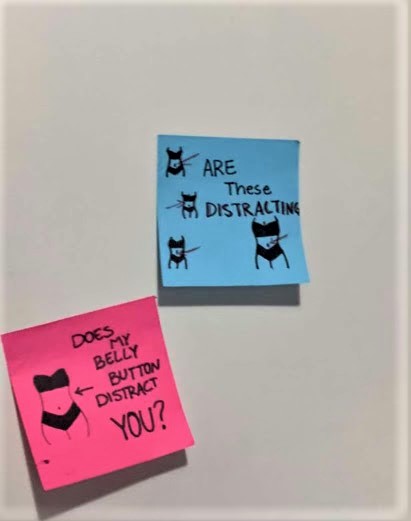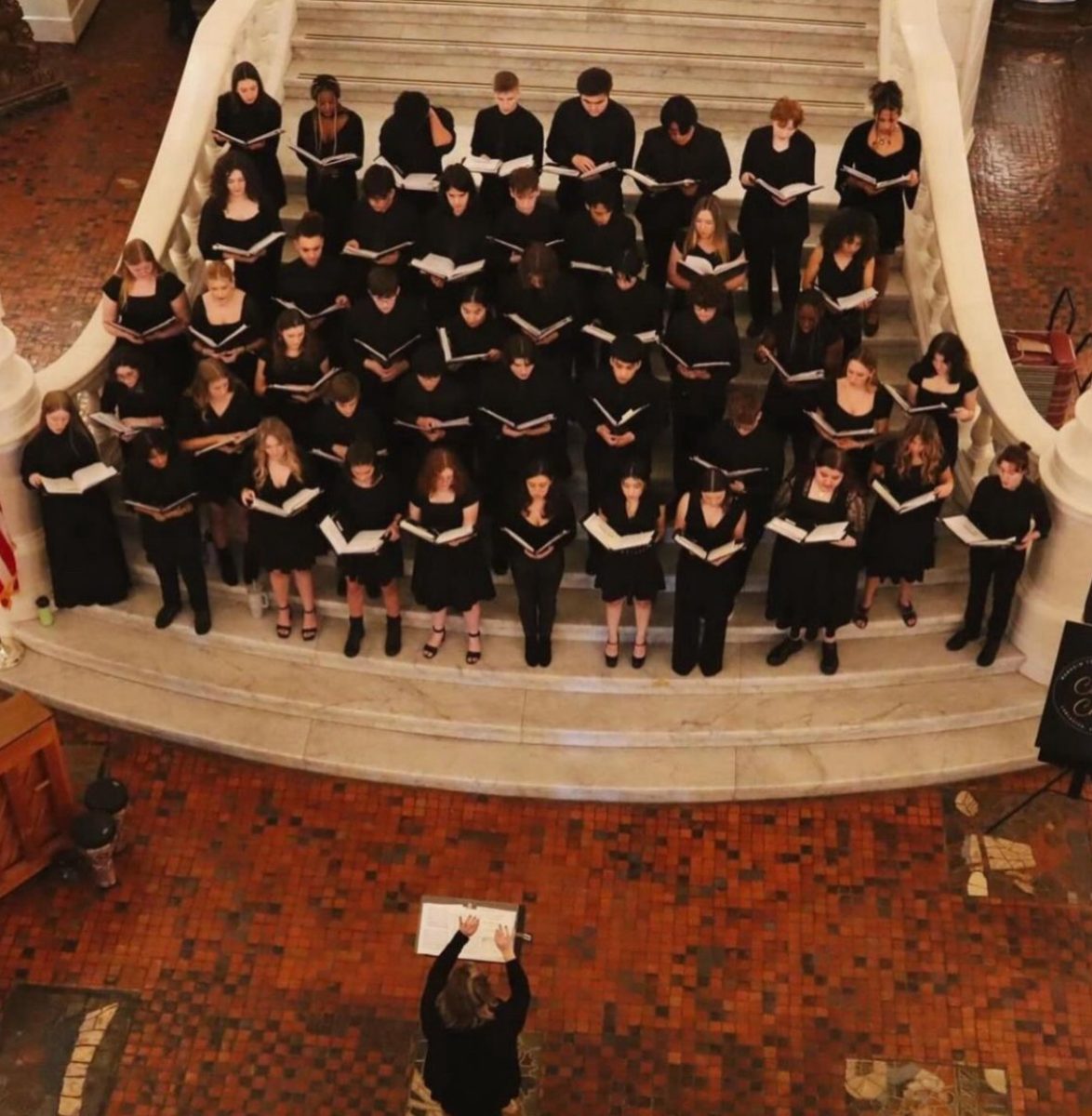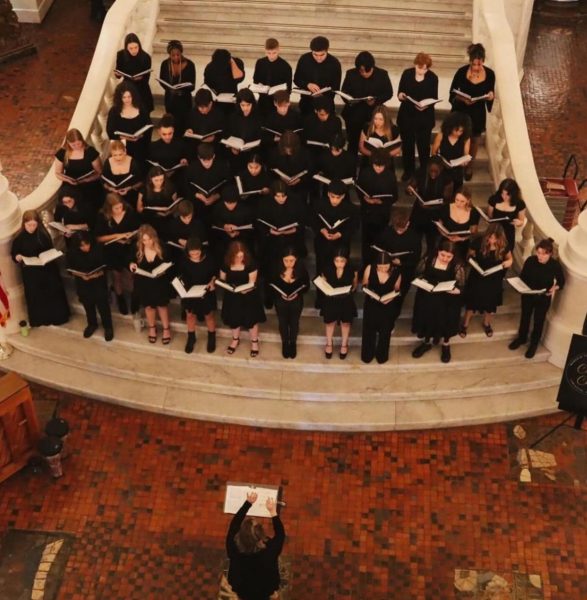Students protest dress code

September 30, 2021
“My education is more important than what I wear.” “Stop sexualizing young women.” “Does my belly button distract you?” These statements might sound familiar. During the week of September 13th, sticky notes with similar statements were posted throughout women’s bathrooms at Manheim Township. This was an attempt to raise awareness for a movement many people in the high school are involved in: the need to change the dress code.
Dress codes have been a part of high schools for as long as anyone can remember. No shorts above your fingertips, no spaghetti straps, no torso showing, etc. At Manheim Township, the dress code is determined by the School Board. While the high school dress code has become more relaxed over the past few years with less rules and regulations, some students still feel restricted.
Sophomore Izzy Fairbanks originally started the movement after being dress-coded for the fourth time this year after she wore a cropped shirt. This was the last straw for Fairbanks, and she felt it was time for a change.
“I come to school for school; I don’t come to school to be looked at. I don’t come to school to be sexualized,” Fairbanks said. Fairbanks, and others like her, feel that they should be comfortable in what they wear without having to constantly worry about whether they are going to be asked to change that day.
Fairbanks began placing sticky notes on the walls of the girls’ bathrooms and handing them out at lunch for others to take part in as well. Soon the school was filled with colorful post-it notes, and the movement was spreading through word of mouth and social media, creating an even larger following of the protests.
Other girls in the school agreed with Fairbanks and thought that the dress code needed to be updated. According to Dahlia Wolfe, the dress code can be exhausting and even stressful. “I was homeschooled for a while, so I didn’t have any sort of dress code then,” she said. “But when I came to public school in 7th grade, there was a very big difference in culture, and it was honestly really anxiety-inducing to have to always be following this dress code.”
Some girls also think that the dress code limits their freedom of expression. Many students use clothes and fashion to make a statement about themselves. For some, it makes up a great deal of who they are.
“I believe that as students we have the right to express ourselves freely without the pressure of sexism, and the dress code simply promotes that,” junior Kloe Stauffer said.
The dress code can also be interpreted as sending young women the wrong message about their bodies. Girls are encouraged to be proud of who they are and what they look like, but some argue that the dress code tells students to cover themselves up and keep their bodies hidden instead.
“It just made me feel, as it makes a lot of others feel, especially women, that our bodies are something to be ashamed of and something to be hidden,” says Wolfe. She went on to say that not only does the dress code set a bad example for how young girls should be viewing themselves, but it also does more to hurt students’ education than to help it. While the intention of the dress code is to keep distractions at a minimum during school, Wolfe believes that “it is more detrimental to our education to be pulled out of class, dress-coded, [and] told to go home or told to change than having a little bit of a torso shown.”
Many girls also bring up another point about the dress code: they think that boys have it easier than girls do in regards to what they can wear. “I’ve always thought that the dress code was unfair and sexist,” sophomore Summer Strauss said. Some say that girls are much more restricted and criticized for what they show, but there are virtually no rules for boys. For example, the dress code against spaghetti straps or the rules on crop tops are all pointed at girls and their bodies, not boys.
“For gym class, the boys only have to wear swim trunks; they don’t have to wear a shirt or anything. But for girls you have to wear a full-piece bathing suit or a T-shirt over your bathing suit,” Fairbanks explained.
This rule forced Fairbanks, along with others, to buy a new one-piece swimsuit for the class, which she says furthers her point that the dress code has some sexist aspects.
Other students were angry at how administration handled the situation; they removed sticky notes off the bathroom walls without an explanation other than that the sticky notes were a distraction. So Abby Kimani, a sophomore, and her friend Alex Maxie decided to speak to administration directly about the situation.
“We talked to Mr. Jones and Mrs. Lyons about how we felt they were trying to silence us by taking down the sticky notes. Mr. Jones said that the sticky notes were a destruction of property and weren’t approved by the school board, which is why he had to take them down,” Kimani said.
Kimani was upset because the administration did not explain their reasoning for taking down the sticky notes and instead just made the students feel unheard. “Mr. Jones explained why he was taking them down, but only because I asked, which I feel is unfair, and I think it would have been better if he announced it to the whole school. To me, it did not feel like he was trying to have a progressive conversation.”
Kimani explained how Mr. Jones claimed that the sticky notes were a one-sided discussion, suggesting that if the students wanted a real change, they would need to have a conversation with administration. He recommended getting a group together and writing down statements on what they want to discuss with the school board and what possible changes they would like to see.
Kimani and Maxie, along with others like Wolfe, Fairbanks, and Strauss, are planning to get a group of representatives together to speak with administration. They are hoping that after reaching out to administration, the School Board will be able to discuss and make changes to the dress code.
Kimani does not want to continue to put up sticky notes, but instead wants to make a real change with her voice. “The sticky notes are just one-sided statements and really won’t have any long term effects, while speaking to administration will make a real change,” she states.
The sticky notes inspired others to speak up and demand a change in a matter that not only helps students express themselves, but also allows them to feel comfortable in an environment where they can learn and be safe.
Editor’s Note: A previous version of this article incorrectly identified Mr. Johns as the administrator involved when it was Mr. Jones.























